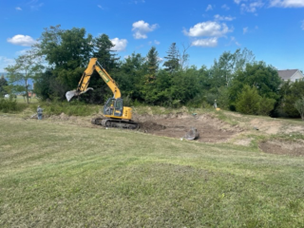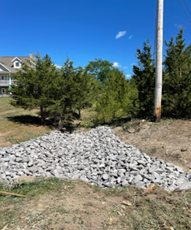 By Anne Jardine
By Anne Jardine
THIS IS A TALE of how it “took a village” to complete needed maintenance on the Lakeshore Landing Seneca Lake residential community’s stormwater management system. Systems to manage stormwater are often vital for preventing pollutants from entering lakes. They can include culverts, stabilized ditches, vegetated swales, and other diversions away from contaminated areas (learn more by visiting senecalake.org/snpr). The updates to the Lakeshore Landing HOA stormwater system in Romulus, New York stem from when the system was largely put in place 80 years ago with the construction of the Sampson Naval Base in 1942. Approximately 20 cottages along the eastern shore of Seneca Lake were annexed for the base, along with acres of farmland. Some of this farmland became the Lakeshore Landing Residential Community when the base was decommissioned and the land sold for development. While the military owned the land, the U.S. Army Corps of Engineers created a series of ditches, concrete culverts and drains to manage the stormwater coming into the base on its way downstream to Seneca Lake. This early system supported the building of military barracks and officer quarters for the Navy, Airforce, and eventual Army Depot living quarters in the early ‘70s. The final stormwater management system was put in place in the early 2000s as the second phase of the residential development for the HOA was undertaken. The Lakeshore Landing Community Association, by merit of our Declaration of Covenants, Conditions and Restrictions, is responsible for the maintenance of that stormwater management system. Over the years, many had tried to move the lumpy ball of maintenance forward, but no progress was being made. A small but determined Storm Water Management Committee was formed to get this lumpy ball unstuck, but there were several obstacles to overcome in executing that mandate. There was a lack of clarity in the Declaration as to the major systems for which the HOA had responsibility and the swale drainage for which the homeowner had responsibility.
There was also a lack of visibility of the work done by the Army Corp of Engineers in order to assess needs, and the extent to which the abandoned drainage coming into the community (from what is now Sampson State Park) was impacting Lakeshore Landing. Other issues included the natural inclination of “if it isn’t broken, don’t fix it.” Additionally, there was a lack of education and belief in climate change’s future potential to cause flooding if the system was not adequately maintained. It was also seen as just plain hard to spend homeowner association money for what “could” happen. Other than the installation of a new lake outlet pipe in 2013 to correct a flooding problem in the southern section of the community, little had been done to maintain the existing system. Unable to convince the Homeowners Association Board to fund a comprehensive drainage engineering study, three homeowner “believers” took it on themselves to fund a day with Scott Fonte of AES Engineering. He inspected two of the three major drainage systems inside of Lakeshore Landing and provided a professional report, recommending immediate maintenance needs. These included:
- The redirecting of the water flow and the armoring of an eroding stormwater ditch that had the potential to flood 8 to 10 homes.
- The digging out of a retention pond and two forebays that had silted up about 3 feet to the emergency runoff pipe, located at the top of the holding basin
- The clearing of a drainage ditch that had become overgrown with woody vegetation (not valuable to water filtration) and that was in jeopardy of further compromising the 80-year-old concrete culverts.
With Fonte giving us his valuable time at the “family discount”, we were able to put some concrete recommendations in front of the HOA Board for their consideration. We also reached out to Erin Peruzzini, the District Manager of the Seneca Lake Soil and Water Conservation, and her technician. Erin had been in and out of the Lakeshore Landing community over the course of more than 12 years, advising numerous Board and Committee members on the stormwater management issues, so was abundantly aware of the needed work. Erin reviewed the engineer’s report, gave us the benefit of her stormwater management wisdom and a list of qualified contractors that could help us with the execution.
Bill Roege of Seneca Lake Pure Waters Association connected us with Ian Smith of the Seneca Watershed Intermunicipal Organization (SWIO). Ian was instrumental in prioritizing the maintenance needs so we could rank order our budgeting purposes. He also added his insight into the entire Seneca Lake watershed impacting our area. Finally, we had a comprehensive proposal to show the HOA Board. By this time, the board had new members. So, the new board and the HOA community needed to be educated on the stormwater system issue, its priority, and how the execution of the maintenance work would unfold. We were grateful to have a Board President, Rich Morgan, who had vision and a demonstrated commitment to the Lakeshore Landing community and Seneca Lake. Rich stood strong against the understandable community concerns of cost and construction disruption with the belief that he was leading a decision in the best interests of the community and the lake. Eventually, the project was approved. Planning and communication were everything as the stormwater system work unfolded. These elements were especially important given the manpower and material shortages of the COVID-19 pandemic, and due to several logistical issues. The developer had neglected to get easements for the drainage ditches that crossed or were contained within some 16 private properties. All adjacent owners needed to provide written approval for property access. A scope of work for the three maintenance initiatives was written based on the drainage engineer’s report and given to four contractors for proposals. Some contractors could only quote on one or two of the initiatives, and some quoted on all. It was our great fortune to be able to secure John Dendis, of J.C. Dendis Construction. A first-class operation, John completed the work on time and within budget. Most importantly, John suggested improvements to the project onsite and worked seamlessly around those inevitable issues that come up while underway. John was not the least expensive quote, but he was absolutely the best for this project. When you don’t have expertise in this complex area of water management, it pays to engage the very best resources you can. Dendis, in combination with the Seneca Lake Soil and Water Conservation District, SWIO, and Seneca Lake Pure Waters Association were an awesome team supporting the Lakeshore Landing Community Association.It took a village, a ton of patience, perseverance and the support of the “believers” but the stormwater system was ultimately a success.
Before and After Pictures Priority # 1 - Drainage Ditch Culvert Diversion & Armoring

BEFORE – Culvert pointing into and eroding embankment.

AFTER – Ditch lined with tech fabric and embankment armored with graduating boulders.
Priority #2 –Retention Pond and Forebays

BEFORE – Silting up to 3’ and overgrown vegetation

AFTER – Cleared and prepped for Seeding
Priority #3 – Drainage ditch and compromised concrete culverts

BEFORE - Overgrown with weed trees rooting into concrete culverts.

AFTER – Weed trees removed, woody vegetation cleared and culverts protected.
.png)